The Rockefeller Museum is an archeological museum affiliated with the Israel Museum but located separately from it in near old town Jerusalem. The building of the museum also houses the offices of the Israel Antiquities Authority. The museum, established by the British Mandate authorities and inaugurated in 1938, is named after the renowned American philanthropist John D. Rockefeller, Jr.

Credit: Ricardo Tulio Gandelman from Rio de Janeiro, Brazil, CC BY 2.0, via Wikimedia Commons
Rockefeller Archeological Museum
So the museum has many important archeological finds from the entire Land of Israel. Prominent finds include the bones of prehistoric man from Nahal Me’arot Nature Reserve at the Carmel Mountain Range, the collection of gold jewelry discovered at Tel el-Ajjul and Beit Shemesh, the treasure of Megiddo ivory, Lachish letters, the stucco reliefs from the Umayyad Hisham’s Palace near Jericho, and the carved stone lintels, dated to the Crusader period from the Facade of the Church of the Holy Sepulcher.

Credit: Talmoryair, CC BY 3.0, via Wikimedia Commons
The Founding of the Rockefeller Archeological Museum
Moreover, with the end of Ottoman rule and the beginning of the British Mandate rule in Jerusalem, there were few cultural institutions in Jerusalem, and they concentrated mainly on religious institutions. The city’s development led to the flourishing of cultural life on the one hand and scientific research and the collection of archaeological finds on the other hand. However, all this contradicted the enormous archeological wealth from all over the Middle East that resulted from the preoccupation of European powers for decades in exposing the treasures of the past.

Daniel Ventura, CC BY-SA 3.0, via Wikimedia Commons
The British Mandate, who saw themselves as the successors of the Crusaders and the children of Israel, showed great interest in discovering the historical past of Jerusalem and the Land of Israel and cultivating archaeological research in those days Palestine. It so happened that the only cultural structure built by the Mandatory government in the country (funded by an American donor) is the Museum of Archeology – the Rockefeller Museum, whose structure is considered one of the most beautiful in Jerusalem.
So the museum’s exhibition halls are built around the inner courtyard, allowing the museum’s treasurer to arrange the exhibits chronologically. The halls are characterized by a rectangular pattern, high ceilings, and windows near the ceiling, letting in softened daylight. The ceiling of the halls was designed using elements from Roman architecture.

Rockefeller Archeological Museum: The Main Courtyard
The inner courtyard, which is the main one, is the museum’s architectural ‘center of gravity’. This courtyard is located in the center of the longitudinal axis of the building and extends over three-tiered levels. In the center of the lowest level is a rectangular ornamental pond that feeds on the water of the storage cisterns at both ends.

The courtyard is bounded by three porticoes that are arcades, similar to a cloister of a medieval monastery. Under the arches, they are placed in large exhibits, such as the Roman Sarcophagi. At the end of the pool is a small cubicle similar to the Mahrab – a niche in the wall of a mosque that points toward Mecca, to which all Muslims should turn during prayer. The walls of the niche are covered with tiles of spectacular Armenian ceramics bearing naturalistic decorations.

Israel Preker Pikiwiki Israel, CC BY 2.5, via Wikimedia Commons
The Visit to the Rockefeller Archeological Museum
A visit to the Rockefeller Museum takes the contemporary visitor back to the beginnings of archeological research in our area. The museum displays rare artefacts, cornerstones of local archeology, mostly from excavations conducted in the first decades of the 20th century. The leading exhibition in the museum spans two halls and is arranged chronologically.

Credit: Dr Avishai Teicher Pikiwiki Israel, CC BY 2.5, via Wikimedia Commons
So the original wooden display cases are full of objects, and they tell the history of mankind in the Land of Israel from the prehistoric period to the Ottoman period – from about a million years ago to the 18th century. Furthermore, among the objects: is a human skull from a quarter of a million years ago that is considered the oldest human remains in the Middle East! Moreover, you can also see the oldest burial in the world from 100,000 years ago! Or the head of a statue of an ancestor from 8,000 years ago from Jericho! And last, a basalt statue of Pharaoh Ramesses III from Beit Shean, Roman marble sarcophagi decorated with reliefs, and more.
Rockefeller Archeological Museum Opening Hours:
Mondays: from 10 am to 3 pm
Wednesdays” from 10 am to 3 pm
Thursdays: from 10 am to 3 pm
Saturdays: from 10 am to 3 pm
Transport and parking:
Bus lines 1, 3, 51
Parking is on Saturday only. During the week, parking in nearby public car parks is possible.
Admission is free and without the need to register in advance.
Contact:
Phone for coordinating group tours: 02-6708884

